Development
In 1864, a civil engineer of Peruvian nationality, born to a German father and Venezuelan mother, Federico Blume Othon (1831–1901), developed the design of the first submarine for the Peruvian Navy. [1] Blume who participated in the construction of railroads in Peru, presented his idea after the Spanish Pacific squadron occupied the Chincha Islands during the Chincha Islands War. His purpose was to create a device that could confront, with minimum risk, the powerful enemy fleet. The result was Toro Submarino (Submarine Bull). It was a revolutionary design for the ships of those days.
She floated and could dive by opening the seacock and filling the ballast tanks. It could also renew the air being submerged using the principle of the snorkel. The war with Spain however came to an end in 1866, and the submarine was not built.
During the Pacific War with Chile, Blume once again offered his services to the Peruvian Navy, presenting an improved version of his 1864 submarine. The engineer started to work on his machine in June 1879, only two months after the declaration of war, financing the project with his own resources. The work was carried out in secrecy during four months at a factory property of the Piura–Paita Northern Railroad. The submarine, a 48-foot-long (15 m) cylindrical, 1⁄4-inch-thick (6.4 mm) iron boiler, bound together by iron strips and rivets, could be operated manually by eight men out of a total crew of eleven who, at the same time, could move the air fans and the water pump. The ventilation tubes were made of brass, and they could be raised or lowered through a special device. Ship instrumentation included internal pressure gauges, depth meter and ballast tank water level.
On October 14, 1879, Blume, together with his son and eight railroad workers, started testing the submarine off the coast of Paita and proved that the submarine could reach incredible results: a depth of 12 ft (3.7 m) with ventilation system and a maximum speed of 3 knots (5.6 km/h; 3.5 mph). Blume perfected the ship, making 18 additional hour-plus dives over the next 24 days, achieving a maximum dive of 72 feet (22 meters) without issue.
News about the amazing weapon reached Supreme Director Nicolás de Piérola, who became very enthusiastic about the idea of using it against the Chilean Navy, so preparations were made to show her capability to the authorities.
Service
The submarine was brought to Callao under the utmost secrecy, hidden in the transport Limeña. In July 1880, Toro Submarino made its first official submersion in presence of the Peruvian Minister of War and Marine Manuel de Mendiburu. During these maneuvers, the submarine remained submerged for 30 minutes without suffering any drawback, proving that it could be used as a reliable weapons platform; the Minister was very impressed. His report to the government about the capabilities of the submarine was favorable, and a decision was made to use it against Chilean warships.
The Peruvian Government appoints a board of mariners and engineers to study improvements to the invention and allocates a fund of S/. 10,000 for the construction of another improved submersible, larger and with superior design characteristics, intending to eliminate the 2 air tubes, using compressed air for the crew to breathe while immersed and eliminating one of the turrets. Thus, an empty keel was added to the hull design in the bow along with an Otto gasoline engine in the stern to give it greater forward speed and greater surface range. The construction of the new submarine was advanced in the Factory of Juan V. Juliá.
However, the adverse development of the war for Peru and the imminent beginning of the Blockade of Callao in 1880, made the Marina de Guerra del Perú order its use and will prepare the "Toro Submarine". The improvement works were carried out in the es: Factoría Naval de Bellavista, the 2 turrets were replaced by only a central one, the ventilation tubes were removed, a small steam engine was adapted to the stern and the torpedoes type Lay or up to 04 naval mines of 10 pounds of dynamite each and time controller that adhered to the cases of an enemy ship. Its main objective would be to advance at night and attack of the enemy ironclad frigates (Almirante Cochrane or Blanco Encalada), that prowled the bay of Callao.
In the first opportunity where the two Chilean ironclad frigates were anchored near the San Lorenzo Island, the attack was prepared, the Toro was already armed and submerged, but the forces Chilean were warned by their spies: "The Peruvians are preparing an attack with a very powerful secret weapon." This warning caused the Chilean squadron to move from its anchorages to the south, with the consequence that the mission was aborted. Since that, Chilean ships would take the precaution of not hovering nearby to avoid attacks with mines or torpedoes.
On January 17, 1881, after the Battle of Miraflores and at the brink of the occupation of the Peruvian capital, Blume's submarine was scuttled with the other ships of the Peruvian fleet to avoid capture by the enemy. The first Peruvian submarine was sunk in front of the Fleteros dock, today Plaza Grau del Callao.
Its crew list included midshipman Manuel Elías Bonnemaison, a survivor of the monitor Huáscar in the Battle of Angamos, as well as a young composer Jose M. Valle Riestra who enrolled voluntarily in the crew.
Some months later, the well-informed Chileans raised it and transferred it to Chile as a war trophy, however, its trail has been definitively lost. Some naval war analysts still believe that, had Toro Submarino been successful, it would have dramatically changed the course of the war in favor of Peru; however, many modern historians have expressed skepticism about this possibility.
Submarine characteristics
This submarine was a cylindrical boiler 48 feet (15 meters) long and 7 wide (2.1 meters). It was built with iron plates 1/4 inch thick, joined by iron strips and rivets and had frame reinforcements every 3 feet.
Blume applied numerous original ideas from the invention of Toro submarine. Its hatches were sealed by rubber friezes and were located in two turrets with visors, its 2 brass ventilation tubes that could be raised and lowered manually by a special device and which had a function of intake and exhaust of air to the interior aided by a blade fan (it was a system that today could be called Snorkel type). The water tank had levels to know the ballast readings during the dive and a piston system to control the ballast in the inversion and surfacing maneuvers. There were also 2 mercury barometers, one measured the internal pressure and the other was connected at one end to the sea, acting as a depth manometer. The propeller had three blades, it was propelled by the muscular work of 8 men on a 7-foot-long shaft, which activated the pair of the propeller, the bilge pump and the fan.
It was manually operated by six to eight men out of a total crew of eleven.

A monitor is a relatively small warship which is neither fast nor strongly armored but carries disproportionately large guns. They were used by some navies from the 1860s, during the First World War and with limited use in the Second World War.
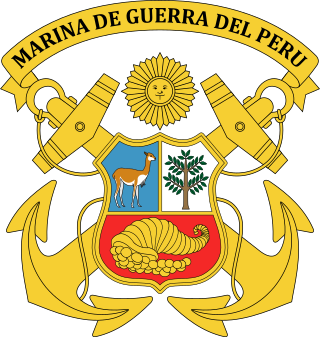
The Peruvian Navy is the branch of the Peruvian Armed Forces tasked with surveillance, patrol and defense on lakes, rivers and the Pacific Ocean up to 200 nautical miles from the Peruvian littoral. Additional missions include assistance in safeguarding internal security, conducting disaster relief operations and participating in international peacekeeping operations.

Huáscar is an ironclad turret ship owned by the Chilean Navy built in 1865 for the Peruvian government. It is named after the 16th-century Inca emperor, Huáscar. She was the flagship of the Peruvian Navy and participated in the Battle of Pacocha and the War of the Pacific of 1879–1883. At the Battle of Angamos, Huáscar, captained by renowned Peruvian naval officer Miguel Grau Seminario, was captured by the Chilean fleet and commissioned into the Chilean Navy.
A crash dive is a maneuver by a submarine in which the vessel submerges as quickly as possible to avoid attack. Crash diving from the surface to avoid attack has been largely rendered obsolete with the advent of nuclear-powered submarines, as they normally operate submerged. However, the crash dive is also a standard maneuver to avoid a collision.

The Battle of Callao occurred on May 2, 1866, between a Spanish fleet under the command of Admiral Casto Méndez Núñez and the fortified battery emplacements of the Peruvian port city of Callao during the Chincha Islands War. The Spanish fleet bombarded the port of Callao, and eventually withdrew without any notable damage to the city structures, according to the Peruvian and American sources; or after having silenced almost all the guns of the coastal defenses, according to the Spanish accounts and French observers. This proved to be the final battle of the war between Spanish and Peruvian forces.
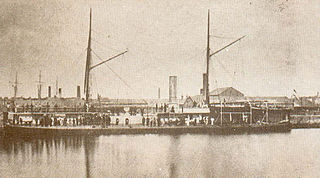
USS Oneota was a single-turreted Canonicus-class monitor built for the Union Navy during the American Civil War. Completed shortly after the end of the war, Oneota was laid up until sold to her builders in 1868, and then resold to the Peruvian Navy. Renamed BAP Manco Cápac, the ship participated in the defense of Arica during the War of the Pacific. When the town was taken by Chilean troops in 1880, she was scuttled to prevent her capture. Her wreck was rediscovered in 1960 and it has been heavily looted.

USS Catawba was a single-turreted Canonicus-class monitor built for the Union Navy during the American Civil War. Completed shortly after the end of the war, Catawba was laid up until sold to her builders in 1868, and then resold to the Peruvian Navy. Renamed BAP Atahualpa, the ship participated in the defense of main port of Peru, Callao, during the War of the Pacific. When the city of Lima was taken by Chilean troops in 1881, she was scuttled to prevent her capture. Atahualpa was later refloated and used as a storage hulk until scrapped in the early 20th century.
The history of the submarine spans the entire history of human endeavour as mankind has since early civilisation sought to explore and travel under the sea. Humanity has employed a variety of methods to travel underwater for exploration, recreation, research and significantly warfare. While early attempts, such as those by Alexander the Great, were rudimentary, the advent of new propulsion systems, fuels, and sonar, propelled an increase in submarine technology. The introduction of the diesel engine, then the nuclear submarine, saw great expansion in submarine use - and specifically military use - during World War I, World War II, and the Cold War. The Second World War use of the U-Boat by the German Navy against the Royal Navy and commercial shipping, and the Cold War's use of submarines by the United States and Russia, helped solidify the submarine's place in popular culture. The latter conflicts also saw an increasing role for the military submarine as a tool of subterfuge, hidden warfare, and nuclear deterrent. The military use of submarines continues to this day, predominantly by North Korea, China, the United States and Russia.
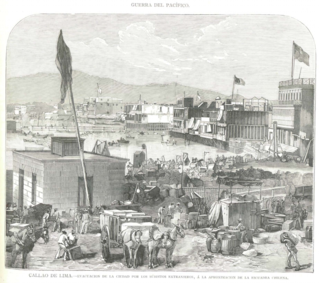
The Blockade of Callao was a military operation that occurred during the War of the Pacific or the Salitre War and that consisted of the Chilean squadron preventing the entry of ships to the port of Callao and the neighboring coves between 10 April 1880 and 17 January 1881.

Flach was the first submarine designed and built in Chile in 1866. It was lost on a test run the same year, and is believed to lie on the seabed of the bay of Valparaiso.
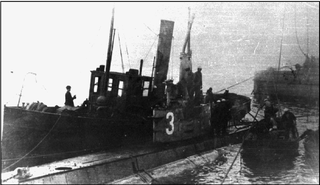
Rucumilla was an H-class submarine of the Chilean Navy. The vessel was originally ordered by the United Kingdom's Royal Navy as HMS H17, but was handed over to Chile in 1917 as H3.
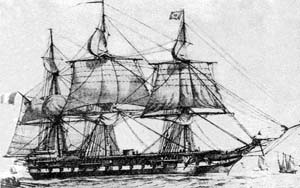
BAP Apurímac was the second steam frigate of the Peruvian Navy, built in England in 1855 along with the steam schooners Loa and Tumbes as a part of a major build-up of the Navy during the government of President José Rufino Echenique. A veteran of two wars and many internal conflicts, due to her age she served as training ship in Callao port from 1873 until January 17, 1881, when she was scuttled along with the rest of the Peruvian Navy to prevent capture by Chilean troops who had occupied the port after the defeat of the Peruvian Army in the battles of San Juan and Miraflores.

BAP Abtao (SS-42) is an Abtao-class submarine of the Peruvian Navy. The vessel which was originally named BAP Tiburón ("Shark"), was constructed by the American Electric Boat company in the United States and launched in 1953. The Abtao class were the last submarines constructed by the United States for the export market. The submarine entered service in 1954 and by presidential decree, was renamed Abtao for the battle during the Chincha Islands War.
Peral was the first successful full electric battery-powered submarine, built by the Spanish engineer and sailor Isaac Peral for the Spanish Navy, in Arsenal de la Carraca. The first fully capable military submarine, she was launched 8 September 1888. She had one torpedo tube and an air regeneration system. Her hull shape, propeller, periscope, torpedo launcher and cruciform external controls anticipated later designs. Her underwater speed was 3 knots. With fully charged batteries, she was the fastest submarine yet built, with underwater performance levels that matched those of First World War U-boats for a very short period, before her batteries began to drain. For example, the SM U-9, a pre-war German U-boat built in 1908, had an underwater speed of 8.1 knots, and an underwater range of 150 km (81 nmi) at 5.8 knots, before having to resurface to recharge her batteries. Although advanced in many ways, Peral lacked a means of charging batteries while underway, such as an internal combustion engine, thus had a very limited endurance and range. In June 1890, Peral's submarine launched a torpedo while submerged. It was also the first submarine to incorporate a fully reliable underwater navigation system. However, conservatives in the Spanish naval hierarchy terminated the project despite two years of successful tests. Her operational abilities have led some to call her the first U-boat.

Águila was the first naval vessel of the Chilean Navy. She was later renamed Pueyrredón.
A semi-submersible naval vessel is a hybrid warship, that combines the properties of a surface ship and submarine by using water ballast to partially immerse and minimize its above-waterline profile, thereby improving its stealth characteristics when in hostile waters. The USS Monitor was an antecedent to such craft with its low-profile deck and gun turret. Russian and North Korean semi-submersible naval vessels evolved from torpedo boats and special forces boats that could partially submerge to perform their missions. The US Navy SEALs use such vessels for clandestine special forces actions. Efforts to embody advantageous surface-ship characteristics into submarines have not been widely adopted.

BAP Almirante Grau was a scout cruiser of the Peruvian Navy, the lead ship of its class. Along with its sister ship Coronel Bolognesi, Almirante Grau was one of Peru's two most powerful warships for the first half of the twentieth century. The ship was named for Miguel Grau Seminario, naval hero of the country.

The Raids of the Huáscar were a series of raids that occurred by the Peruvian ironclad Huáscar under the command of Miguel Grau Seminario during the War of the Pacific. The actions kept the Chilean government in check for nearly five months which ended after the Battle of Angamos.

The Rupture of the Blockade of Arica was a naval battle of the War of the Pacific during the Blockade of Arica. The rupture was carried out by Manuel Villavicencio who commanded the BAP Unión of the Peruvian Navy. The Unión broke the Chilean blockade of the port twice in less than 8 hours on March 17, 1880.















